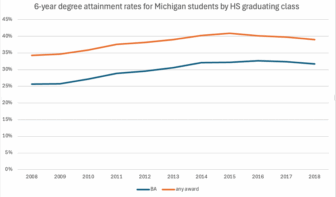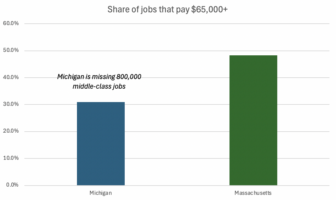More than a decade of research on the changing American economy has led us to conclude that, quite simply, in a flattening world where work can increasingly be done anyplace by anybody, the places with the greatest concentrations of talent win. The new path to prosperity is concentrated talent. Human capital is what attracts business investment and characterizes those places with the most business start ups.
The places where talent is concentrating are increasingly big metros with vibrant central cities. Central cities because mobile talent increasingly want to live in high-density, high-amenity neighborhoods where you don’t have to own a car.
It far past time that Michigan learn this new reality: Place attracts talent. And talent = economic growth.
What follows are the placemaking priorities for Michigan to be competitive in retaining and attracting mobile talent
Metropolitan Detroit and Grand Rapids as the priority
The two metros make up more than half the state’s population. And, almost certainly, far more that half of the state’s gross state product and tax revenue. They are the engines of the Michigan economy today and will be even more so in the future as the economy becomes more knowledge-based.
The main reason why Minnesota is a high-prosperity state––with the best economic outcomes in the Great Lakes––and Michigan a low-prosperity state is that metro Minneapolis is high prosperity and metro Detroit and Grand Rapids are not. Take those big metros out and the two states don’t look that different.
So the key to Michigan’s return to high prosperity is metro Detroit and Grand Rapids becoming talent magnets and knowledge-based services centered. And that means that their two central cities must become preferred places for recent college graduates to want to live and work after graduation.
State policy needs to recognize the strategic importance of its two big metros and their central cities. In all the categories that follow making sure they work for metro Detroit and Grand Rapids should be a top priority.
State funding for basic services and amenities
Something needs to replace the decade of cuts to revenue sharing. The state has historically helped fund the provision of local services. The combination of stricter and stricter limits on local government’s taxing power and revenue sharing and transportation funding cuts results in even the best managed cities unable to provide the basic services and amenities needed to retain and attract residents.
If the state will not reinvest in cities, then there needs to be some new system of municipal finance put in place. Best done at the regional level. The current system leaves cities without the tax base to fund the services that are needed.
Public safety matters most. People aren’t safe and/or don’t feel safe they will leave and potential newcomers will not stay. This is police, but more. Lighting, clean, code enforcement, etc. matter too.
Amenities that matter most, after alternatives to driving, are parks and the arts.
Transportation is the lever that can best steer development
For decades we have had––and still do––policies that favor roads and suburban and rural communities. We need a change in transportation funding and policy that makes transit––in metro Detroit that needs to include light rail at least on Woodward from Detroit to Birmingham––biking, walking etc. a higher priority and steers funding towards big metros and their central cities.
21st Century transportation systems need to be far more balanced. Not just designed for cars, but for walking, bikes, and transit, transit, transit. Places with less car-centric transportation systems are going to do better at retaining and attracting mobile talent.
If we are serious about building a 21st Century transportation system there are four steps we should take:
- Fund roads on the basis of population, not road miles
- Increase the funding for transit to the state constitutional maximum and––as Minnesota does––use general funds to fund transit
- Adopt complete streets as the basis for transportation design rather than the current policy of ever wider and wider roads to move cars faster and faster
- Stop major road expansion projects like the widening of I94 and I75 in metro Detroit
Why light rail? Across the country––in every region and in both red and blue states––big metros have made rail transit a key component of their development strategy. (You can find a list of all the metros with rail transit systems here. Its a very long list.)
These are the places that metro Detroit and Grand Rapids are competing with for both talent and business investment. They all have and/or are making big public investments in regional rail transit systems. In nearly every case they have passed tax increases, with active business and political support from across the region, not just the central city.
Restore urban development incentives
Quite simply the historic preservation and brownfield tax credits need to be restored. They worked. And there still is a gap between what the market will bear in terms of price (even with subsidies like Live Midtown and Live Downtown now in place in Detroit) and what it costs to redevelop.
For decades (and continuing) government has subsidized suburban housing (single family, home ownership). Why is that “right” and subsidizing urban housing (multifamily, likely mixed use, and largely rental) “wrong”?
Regulatory policy that favors walkable urbanism
At the state, regional and local levels regulatory policy––in addition to funding––favors drivable suburbanism rather than walkable urbanism. That needs to change so that central cities and inner ring suburbs can meet the growing market demand for walkable urbanism. Which means policies that:
- Are favorable to very high densities
- Are favorable to mixed use neighborhoods
- Do not discourage––maybe even encourage––rental residential development
- Have transportation designed to keep people in cities and help them move around without a car rather than making it easy to get out of cities in cars
- Understand that streets are first and foremost for people, not cars.






